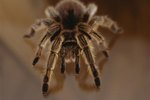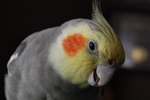
Shedding and molting appear to be similar processes, but they are vastly different in purpose and technique. Animals with fur shed, while animals with exoskeletons and some reptiles molt. Shedding is nature's way of preparing the animal for seasonal changes, while molting prepares the animal for a new stage of growth.
Shedding

All mammals with fur or hair, including humans, shed. When humans lose hair, it's like when a non-human animal sheds. The hair follicle dies and the hair falls off. Most all furry critters shed in response to seasonal changes. In dog industry parlance, it's called "blowing their coat." Even those dogs considered hypoallergenic, such as poodles, shed a little. The hair that is shed just gets tangled in with the natural curls of the coat so there's not much to sweep up off the floor, giving the impression they don't shed. As the seasons change, hormonal changes in the animal trigger the shedding response. When it gets colder, the coat comes in thick. But as the weather warms, the fur begins to fall out, thinning the coat in preparation for the higher temperatures. Even polar bears, who live in cold weather year-round, shed their coats annually.
Molting

When humans grow, their skin grows along with them. It's hard to imagine not having skin that grows. But some animals have skin that doesn't grow. Animals that molt for this reason are found in the insect, arachnid, crustacean and reptile families. The technical term for the process of molting is "ecdysis." Arachnids such as tarantulas and scorpions and many insects with exoskeletons molt. An animal with an exoskeleton has its "bones" on the outside, rather than the inside. It serves the same purpose as the human skeleton, only it's visible and gives some animals a hardened shell. Since the shell is hard, it must be removed from time to time as the animal's body grows naturally to allow room for the larger body. In the case of snakes, who don't have a hard outer shell, they shed their skin because it doesn't grow with them like human skin. Therefore, as the snake grows, he must shed his outer skin in order to grow new skin.
Feathered Friends

Birds molt, but not because they need room to grow. Feathers don't rejuvenate when damaged. So instead, a broken feather falls off and a new one grows in to take its place. Birds also molt on a regular basis. As with many mammals, birds respond to seasonal changes, which trigger a hormonal response in the bird. The degree and frequency of molting varies with the species of bird. Some birds molt only once a year, some more often than that. As new feathers come in, in many species you can tell if the bird is a juvenile by the coloring. For example, the white ibis is born with dark brown feathers, which are gradually replaced by the snowy white feathers as they mature into adulthood.
Fun Facts About Molting and Shedding

House cats shed throughout the year since they are not at the mercy of weather changes. They have lost their ability -- and need -- to make use of their coats to keep them warm in winter. While owls and hawks molt only once a year, birds that live amid thick vegetation, such as the wren, molt twice a year because of harsh conditions that damage their feathers. Shedding has little to no significance on the animal's ability to carry on daily activities, but molting causes a vulnerability in many animals. The tarantula and the snake are two such species. When they are molting, they are undergoing a stressful time and the "skin" underneath is fragile and new, so they're easily injured. Molting in tarantulas is complicated because of the eight-legged physiology and tarantulas can easily lose a leg (which is replaced by an inferior limb) during the process.
References
- Reptile Knowledge: Snake Shedding 101 - Why Snakes Shed Their Skin
- Cornell Center for Materials Research: Sunlight Plays Major Role in Cats' Hair Cycles
- Dog Breed Info Center: Shedding Dogs
- SeaWorld: Polar Bears
- Tarantuala Guide: Molting
- BlueCrab.info: Growth and Molting
- The Cornell Lab of Ornithology: Molting
- Audobon: White Ibis
Resources
Photo Credits
-
Ablestock.com/AbleStock.com/Getty Images
Writer Bio
Michelle A. Rivera is the author of many books and articles. She attended the University of Missouri Animal Cruelty School and is certified with the Florida Animal Control Association. She is the executive director of her own nonprofit, Animals 101, Inc. Rivera is an animal-assisted therapist, humane educator, former shelter manager, rescue volunteer coordinator, dog trainer and veterinary technician.




